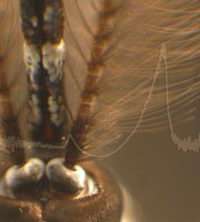How to catch a mosquito

Male mosquitoes increase their chances of mating with a passing female by enhancing their ability to hear her flying past. Much like the human ear, the mosquito ear is able to amplify the sounds it hears, making the female appear closer.
New research from the University of Bristol, UK, shows that mosquitoes’ auditory cells react to vibrations caused by the sound of the female’s wing-beat and then generate vibrations to boost this signal.
The research is published in the Proceedings of the National Academy of Sciences (PNAS).
Professor Daniel Robert from the University of Bristol and senior author on the paper said: “To our surprise, we found that the mosquito ear mechanically responds to enlarge its own range of detection. It makes the female appear closer than she actually is, giving the male a split second longer in which to react.”
This behaviour enhances the male’s chance to capture and mate with a passing female. It may also be why such small animals have, comparatively speaking, such large ears.
Males detect female mosquitoes by the sounds generated by their wing-beat. As female wings are poor acoustic radiators – they don’t make much noise – males have been driven, by sexual selection, to evolve highly sensitive acoustic sensors.
In addition, the sounds of females are very momentary. Female sounds appear and vanish very suddenly, leaving the male with just a split second in which to detect her. A reflection of the demands of this task may be the fact that the ears of male mosquitoes contain up to sixteen thousand sensory cells, a number comparable to that contained in the human ear.
Using a laser vibrometer to measure the tiny vibrations of the male’s antenna and appropriately simulated female sounds, the Bristol team showed that the mosquito antenna reacts to improve its own sensitivity to female sounds. Using these mathematically well-defined stimuli, several (nonlinear) response features were unveiled that had not been previously reported in sensory systems.
Source: University of Bristol



















